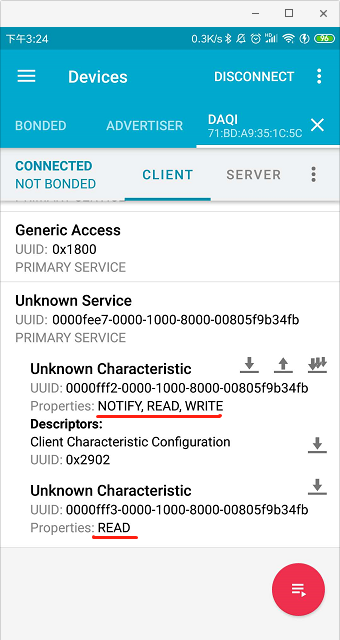在蓝牙开发中,有些情况是不需要连接的,只要外设广播自己的数据即可,例如苹果的ibeacon。自Android 5.0更新蓝牙API后,手机可以作为外设广播数据。
广播包有两种:
- 广播包(Advertising Data)
- 响应包(Scan Response)
其中广播包是每个外设都必须广播的,而响应包是可选的。每个广播包的长度必须是31个字节,如果不到31个字节 ,则剩下的全用0填充 补全,这部分的数据是无效的

广播数据单元
广播包中包含若干个广播数据单元,广播数据单元也称为 AD Structure。
广播数据单元 = 长度值Length + AD type + AD Data。
长度值Length只占一个字节,并且位于广播数据单元的第一个字节。
概念的东西有些抽象,先看看下面的广播报文:
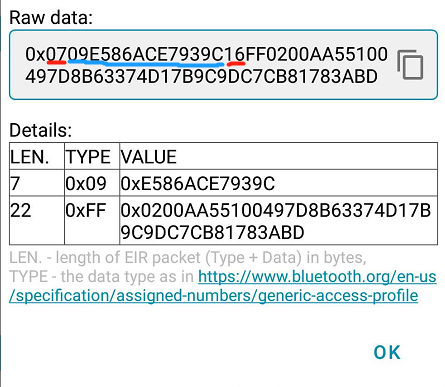
0x代表这串字符串是十六进制的字符串。两位十六进制数代表一个字节。因为两个字符组成的十六进制字符串最大为FF,即255,而Java中byte类型的取值范围是-128到127,刚好可以表示一个255的大小。所以两个十六进制的字符串表示一个字节。
继续查看报文内容,开始读取第一个广播数据单元。读取第一个字节:0x07,转换为十进制就是7,即表示后面的7个字节是这个广播数据单元的数据内容。超过这7个字节的数据内容后,表示是一个新的广播数据单元。
而第二个广播数据单元,第一个字节的值是0x16,转换为十进制就是22,表示后面22个字节为第二个广播数据单元。
在广播数据单元的数据部分中,第一个字节代表数据类型(AD type),决定数据部分表示的是什么数据。(即广播数据单元第二个字节为AD type)
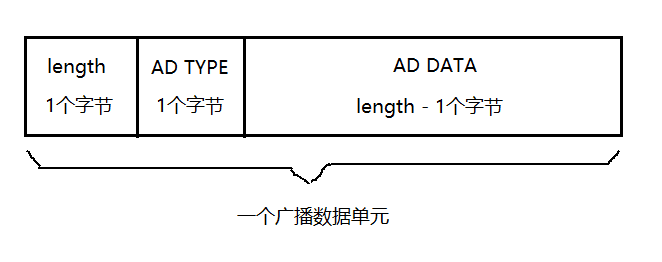
AD Type的类型如下:
- Flags:TYPE = 0x01。用来标识设备LE物理连接。
- bit 0: LE 有限发现模式
- bit 1: LE 普通发现模式
- bit 2: 不支持 BR/EDR
- bit 3: 对 Same Device Capable(Controller) 同时支持 BLE 和 BR/EDR
- bit 4: 对 Same Device Capable(Host) 同时支持 BLE 和 BR/EDR
- bit 5..7: 预留
这bit 1~7分别代表着发送该广播的蓝牙芯片的物理连接状态。当bit的值为1时,表示支持该功能。 例:
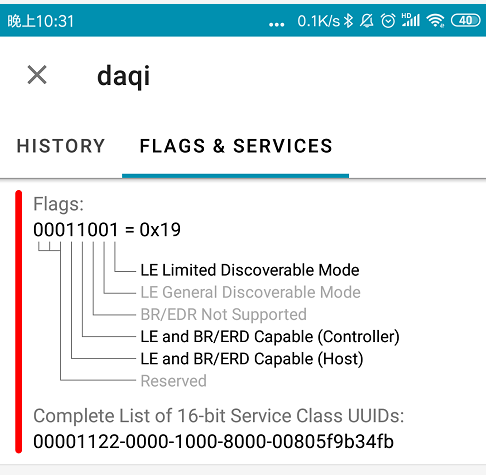
-
Service
UUID。广播数据中可以将设备支持的GATT Service的UUID广播出来,来告知中心设备其支持的Service。对于不同bit的UUID,其对应的类型也有不同:- 非完整的16bit
UUID: TYPE = 0x02; - 完整的16bit
UUID列表: TYPE = 0x03; - 非完整的32bit
UUID列表: TYPE = 0x04; - 完整的32bit
UUID列表: TYPE = 0x05; - 非完整的128bit
UUID列表: TYPE = 0x06; - 完整的128bit
UUID: TYPE = 0x07;
- 非完整的16bit
-
TX Power Level: TYPE = 0x0A,表示设备发送广播包的信号强度。 数值范围:±127 dBm。
-
设备名字,DATA 是名字的字符串,可以是设备的全名,也可以是设备名字的缩写。
- 缩写的设备名称: TYPE = 0x08
- 完整的设备名称: TYPE = 0x09
-
Service Data: Service 对应的数据。
- 16 bit
UUIDService: TYPE = 0x16, 前 2 字节是UUID,后面是 Service 的数据; - 32 bit
UUIDService: TYPE = 0x20, 前 4 字节是UUID,后面是 Service 的数据; - 128 bit
UUIDService: TYPE = 0x21, 前 16 字节是UUID,后面是 Service 的数据;
- 16 bit
-
厂商自定义数据: TYPE = 0xFF。厂商数据中,前两个字节表示厂商ID,剩下的是厂商自定义的数据。
BLE广播
蓝牙广播的数据格式大致讲了一下,有助于下面的广播操作的理解。
自定义UUID:
//`UUID`
public static `UUID` UUID_SERVICE = `UUID`.fromString("0000fff7-0000-1000-8000-00805f9b34fb");
开启广播一般需要3~4对象:广播设置(AdvertiseSettings)、广播包(AdvertiseData)、扫描包(可选)、广播回调(AdvertiseCallback)。
广播设置
先看看广播设置(AdvertiseSettings)如何定义:
//初始化广播设置
mAdvertiseSettings = new AdvertiseSettings.Builder()
//设置广播模式,以控制广播的功率和延迟。
.setAdvertiseMode(AdvertiseSettings.ADVERTISE_MODE_LOW_POWER)
//发射功率级别
.setTxPowerLevel(AdvertiseSettings.ADVERTISE_TX_POWER_HIGH)
//不得超过180000毫秒。值为0将禁用时间限制。
.setTimeout(3000)
//设置是否可以连接
.setConnectable(false)
.build();
(1)、通过AdvertiseSettings.Builder#setAdvertiseMode() 设置广播模式。其中有3种模式:
- 在均衡电源模式下执行蓝牙LE广播:
AdvertiseSettings#ADVERTISE_MODE_BALANCED - 在低延迟,高功率模式下执行蓝牙LE广播:
AdvertiseSettings#ADVERTISE_MODE_LOW_LATENCY - 在低功耗模式下执行蓝牙LE广播:
AdvertiseSettings#ADVERTISE_MODE_LOW_POWER
(2)、通过AdvertiseSettings.Builder#setAdvertiseMode() 设置广播发射功率。共有4种功率模式:
- 使用高TX功率级别进行广播:
AdvertiseSettings#ADVERTISE_TX_POWER_HIGH - 使用低TX功率级别进行广播:
AdvertiseSettings#ADVERTISE_TX_POWER_LOW - 使用中等TX功率级别进行广播:
AdvertiseSettings#ADVERTISE_TX_POWER_MEDIUM - 使用最低传输(TX)功率级别进行广播:
AdvertiseSettings#ADVERTISE_TX_POWER_ULTRA_LOW
(3)、通过AdvertiseSettings.Builder#setTimeout()设置持续广播的时间,单位为毫秒。最多180000毫秒。当值为0则无时间限制,持续广播,除非调用BluetoothLeAdvertiser#stopAdvertising()停止广播。
(4)、通过AdvertiseSettings.Builder#setConnectable()设置该广播是否可以连接的。
广播包
之前说过,外设必须广播广播包,扫描包是可选。但添加扫描包也意味着广播更多得数据,即可广播62个字节。
//初始化广播包
mAdvertiseData = new AdvertiseData.Builder()
//设置广播设备名称
.setIncludeDeviceName(true)
//设置发射功率级别
.setIncludeDeviceName(true)
.build();
//初始化扫描响应包
mScanResponseData = new AdvertiseData.Builder()
//隐藏广播设备名称
.setIncludeDeviceName(false)
//隐藏发射功率级别
.setIncludeDeviceName(false)
//设置广播的服务`UUID`
.addService`UUID`(new Parcel`UUID`(UUID_SERVICE))
//设置厂商数据
.addManufacturerData(0x11,hexStrToByte(mData))
.build();
可见无论是广播包还是扫描包,其广播的内容都是用AdvertiseData类封装的。
(1)、AdvertiseData.Builder#setIncludeDeviceName()方法,可以设置广播包中是否包含蓝牙的名称。
(2)、AdvertiseData.Builder#setIncludeTxPowerLevel()方法,可以设置广播包中是否包含蓝牙的发射功率。
(3)、AdvertiseData.Builder#addServiceUUID(ParcelUUID)方法,可以设置特定的UUID在广播包中。
(4)、AdvertiseData.Builder#addServiceData(ParcelUUID,byte[])方法,可以设置特定的UUID和其数据在广播包中。
(5)、AdvertiseData.Builder#addManufacturerData(int,byte[])方法,可以设置特定厂商Id和其数据在广播包中。
从AdvertiseData.Builder的设置中可以看出,如果一个外设需要在不连接的情况下对外广播数据,其数据可以存储在UUID对应的数据中,也可以存储在厂商数据中。但由于厂商ID是需要由Bluetooth SIG进行分配的,厂商间一般都将数据设置在厂商数据。
广播名称
另外可以通过BluetoothAdapter#setName()设置广播的名称
//获取蓝牙设配器
BluetoothManager bluetoothManager = (BluetoothManager)
getSystemService(Context.BLUETOOTH_SERVICE);
mBluetoothAdapter = bluetoothManager.getAdapter();
//设置设备蓝牙名称
mBluetoothAdapter.setName("daqi");
发送BLE广播
先看一个例子,我们分别在广播包和扫描包中设置AdvertiseData.Builder的每一种广播报文参数,得到一下报文内容:
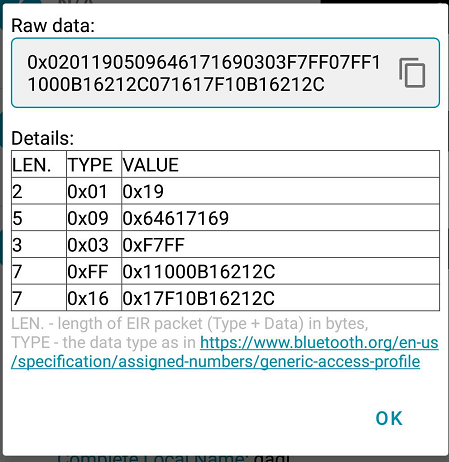
(1)、Type = 0x01 表示设备LE物理连接。
(2)、Type = 0x09 表示设备的全名
(3)、Type = 0x03 表示完整的16bit UUID。其值为0xFFF7。
(4)、Type = 0xFF 表示厂商数据。前两个字节表示厂商ID,即厂商ID为0x11。后面的为厂商数据,具体由用户自行定义。
(5)、Type = 0x16 表示16 bit UUID的数据,所以前两个字节为UUID,即UUID为0xF117,后续为UUID对应的数据,具体由用户自行定义。
最后继承AdvertiseCallback自定义广播回调。
private class daqiAdvertiseCallback extends AdvertiseCallback {
//开启广播成功回调
@Override
public void onStartSuccess(AdvertiseSettings settingsInEffect){
super.onStartSuccess(settingsInEffect);
Log.d("daqi","开启服务成功");
}
//无法启动广播回调。
@Override
public void onStartFailure(int errorCode) {
super.onStartFailure(errorCode);
Log.d("daqi","开启服务失败,失败码 = " + errorCode);
}
}
初始化完毕上面的对象后,就可以进行广播:
//获取BLE广播的操作对象。
//如果蓝牙关闭或此设备不支持蓝牙LE广播,则返回null。
mBluetoothLeAdvertiser = mBluetoothAdapter.getBluetoothLeAdvertiser();
//mBluetoothLeAdvertiser不为空,且蓝牙已开打
if(mBluetoothAdapter.isEnabled()){
if (mBluetoothLeAdvertiser != null){
//开启广播
mBluetoothLeAdvertiser.startAdvertising(mAdvertiseSettings,
mAdvertiseData, mScanResponseData, mAdvertiseCallback);
}else {
Log.d("daqi","该手机不支持ble广播");
}
}else{
Log.d("daqi","手机蓝牙未开启");
}
广播主要是通过BluetoothLeAdvertiser#startAdvertising()方法实现,但在之前需要先获取BluetoothLeAdvertiser对象。
BluetoothLeAdvertiser对象存在两个情况获取为Null:
- 手机蓝牙模块不支持BLE广播
- 蓝牙未开启
所以在调用BluetoothAdapter#getBluetoothLeAdvertiser()前,需要先调用判断蓝牙已开启,并判断在BluetoothAdapter中获取的BluetoothLeAdvertiser是否为空(测试过某些华为手机mBluetoothAdapter.isMultipleAdvertisementSupported()为 false, 但是能发送ble广播)。
与广播成对出现就是BluetoothLeAdvertiser.stopAdvertising()停止广播了,传入开启广播时传递的广播回调对象,即可关闭广播:
mBluetoothLeAdvertiser.stopAdvertising(mAdvertiseCallback)
启动GATT Service 和 Characteristic
虽然通过广播告知外边自身拥有这些Service,但手机自身并没有初始化Gattd的Service。导致外部的中心设备连接手机后,并不能找到对应的GATT Service 和 获取对应的数据。
创建Gatt Service
Service类型有两个级别:
BluetoothGattService#SERVICE_TYPE_PRIMARY主服务BluetoothGattService#SERVICE_TYPE_SECONDARY次要服务(存在于主服务中的服务)
创建BluetoothGattService时,传入两个参数:UUID和Service类型:
BluetoothGattService service = new BluetoothGattService(UUID_SERVICE,
BluetoothGattService.SERVICE_TYPE_PRIMARY);
创建Gatt Characteristic
我们都知道Gatt中,Service的下一级是Characteristic,Characteristic是最小的通信单元,通过对Characteristic进行读写操作来进行通信。
//初始化特征值
mGattCharacteristic = new BluetoothGattCharacteristic(UUID_CHARACTERISTIC,
BluetoothGattCharacteristic.PROPERTY_WRITE|
BluetoothGattCharacteristic.PROPERTY_NOTIFY|
BluetoothGattCharacteristic.PROPERTY_READ,
BluetoothGattCharacteristic.PERMISSION_WRITE|
BluetoothGattCharacteristic.PERMISSION_READ);
创建
BluetoothGattCharacteristic时,传入三个参数:UUID、特征属性 和 权限属性。
特征属性表示该BluetoothGattCharacteristic拥有什么功能,即能对BluetoothGattCharacteristic进行什么操作。其中主要有3种:
BluetoothGattCharacteristic#PROPERTY_WRITE表示特征支持写BluetoothGattCharacteristic#PROPERTY_READ表示特征支持读BluetoothGattCharacteristic#PROPERTY_NOTIFY表示特征支持通知
权限属性用于配置该特征值所具有的功能。主要两种:
BluetoothGattCharacteristic#PERMISSION_WRITE特征写权限BluetoothGattCharacteristic#PERMISSION_READ特征读权限
注意事项
- 当特征值只有读权限时,调用
BluetoothGatt#writeCharacteristic()对特征值进行修改时,将返回false,无法写入。并不会触发BluetoothGattCallback#onCharacteristicWrite()回调。 - 当特征值只有写权限时,调用
BluetoothGatt#readCharacteristic()对特征值进行读取时,将返回false,无法写入。并不会触发BluetoothGattCallback#onCharacteristicRead()回调。
创建Gatt Descriptor
Characteristic下还有Descriptor,初始化BluetoothGattDescriptor时传入:Descriptor UUID 和 权限属性
//初始化描述
mGattDescriptor = new BluetoothGattDescriptor(UUID_DESCRIPTOR,BluetoothGattDescriptor.PERMISSION_WRITE);
添加 Characteristic 和 Descriptor
为Service添加Characteristic,为Characteristic添加Descriptor:
//Service添加特征值
mGattService.addCharacteristic(mGattCharacteristic);
mGattService.addCharacteristic(mGattReadCharacteristic);
//特征值添加描述
mGattCharacteristic.addDescriptor(mGattDescriptor);
通过蓝牙管理器mBluetoothManager获取Gatt Server,用来添加Gatt Service。添加完Gatt Service后,外部中心设备连接手机时,将能获取到对应的GATT Service 和 获取对应的数据
//初始化GattServer回调
mBluetoothGattServerCallback = new daqiBluetoothGattServerCallback();
if (mBluetoothManager != null)
mBluetoothGattServer = mBluetoothManager.openGattServer(this, mBluetoothGattServerCallback);
boolean result = mBluetoothGattServer.addService(mGattService);
if (result){
Toast.makeText(daqiActivity.this,"添加服务成功",Toast.LENGTH_SHORT).show();
}else {
Toast.makeText(daqiActivity.this,"添加服务失败",Toast.LENGTH_SHORT).show();
}
定义Gatt Server回调。当中心设备连接该手机外设、修改特征值、读取特征值等情况时,会得到相应情况的回调。
private class daqiBluetoothGattServerCallback extends BluetoothGattServerCallback{
//设备连接/断开连接回调
@Override
public void onConnectionStateChange(BluetoothDevice device, int status, int newState) {
super.onConnectionStateChange(device, status, newState);
}
//添加本地服务回调
@Override
public void onServiceAdded(int status, BluetoothGattService service) {
super.onServiceAdded(status, service);
}
//特征值读取回调
@Override
public void onCharacteristicReadRequest(BluetoothDevice device, int requestId, int offset, BluetoothGattCharacteristic characteristic) {
super.onCharacteristicReadRequest(device, requestId, offset, characteristic);
}
//特征值写入回调
@Override
public void onCharacteristicWriteRequest(BluetoothDevice device, int requestId, BluetoothGattCharacteristic characteristic, boolean preparedWrite, boolean responseNeeded, int offset, byte[] value) {
super.onCharacteristicWriteRequest(device, requestId, characteristic, preparedWrite, responseNeeded, offset, value);
}
//描述读取回调
@Override
public void onDescriptorReadRequest(BluetoothDevice device, int requestId, int offset, BluetoothGattDescriptor descriptor) {
super.onDescriptorReadRequest(device, requestId, offset, descriptor);
}
//描述写入回调
@Override
public void onDescriptorWriteRequest(BluetoothDevice device, int requestId, BluetoothGattDescriptor descriptor, boolean preparedWrite, boolean responseNeeded, int offset, byte[] value) {
super.onDescriptorWriteRequest(device, requestId, descriptor, preparedWrite, responseNeeded, offset, value);
}
}
最后开启广播后,用nRF连接后看到的特征值信息如下图所示:(加多了一个只能都的特征值)
